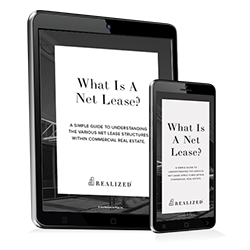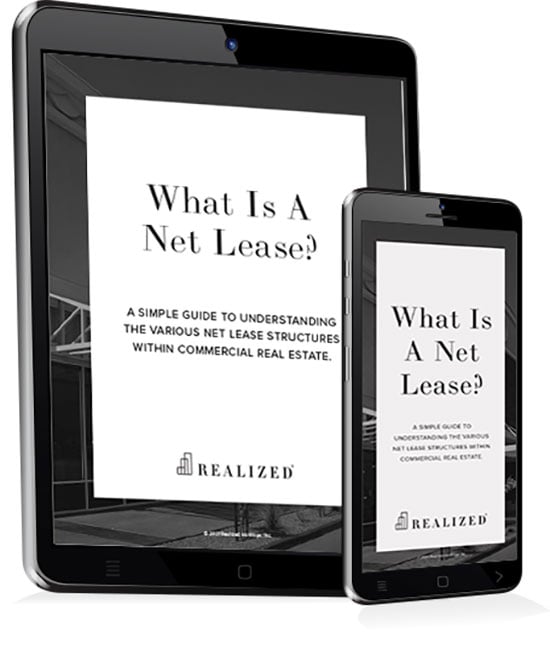
Triple net leases, also called NNN leased properties, can potentially offer real estate investors several advantages over other types of lease structures, but they aren’t without their potential drawbacks, either.
While any type of commercial real estate can have a triple net lease tenant, they are most common in the retail and office sectors. In this article we’ll take a look at some of the common pros and cons of NNN lease properties, and highlight many of the tenants that prefer this lease structure to give investors a baseline guide when they are considering triple net lease investment opportunities.
Net Lease Structures
There are four primary net lease structures: single, double, triple, and absolute. In the first two, the tenant pays their monthly rental rate and one or two major operating expenses, respectively.
In a triple net lease, the tenant pays for the three largest property operating expenses:
- Property tax
- Building maintenance
- Insurance
In an absolute lease, the tenant pays for all of these operating expenses and any other expenses that may arise during their lease term, such as parking lot repaving or replacing the building’s roof. In a triple net lease, major mechanical, structural, or lot repairs are the property owner’s responsibility.
Potential Benefits and Drawbacks of Triple Net Lease Properties
NNN lease properties may appeal to investors who want the potential benefits that come with owning commercial real estate with little to no management duties.
Five of the primary benefits typically tied to triple net lease properties include:
- Long-term leases. NNN leases are inked for lengthy terms – sometimes up to 25 years. These steady rental payments can be a beneficial income stream.
- Creditworthy tenants. This potential benefit can be extremely important for investors attempting to manage risk. Tenants who typically prefer NNN leased properties often have strong credit ratings and a substantial national footprint. Many are publicly traded. Think well-known coffee chains, drug stores, discount retailers, quick-serve, and fast-food eateries.
- Regular rent increases. Contractual increases to the tune of 1.5 to 3 percent annually are often baked into NNN lease agreements.
- Passive income. Since the tenant is responsible for paying the property’s major operating expenses, the time commitment and financial burden of managing the property is lifted from the owner’s shoulders.
- Increased exit opportunities. Single tenant net leased assets routinely change hands, especially in hot real estate markets. Investors may have increased opportunities to exit their investments.
Now that we’ve highlighted some of the reasons why some commercial real estate investors prefer NNN lease opportunities, we’ll point out a few potential drawbacks. High cost of entry can be a primary drawback — triple net lease properties usually sell for compressed capitalization rates, which limits their upside. Since they are mostly passive investments, experienced real estate investors don’t have the opportunity to leverage their expertise in an attempt to increase returns or add value to their investments. Lastly, single tenant net leased assets present a high vacancy risk – if the current tenant declines to renew its lease and vacates, property owners are left with dark spaces that may require extensive tenant improvements and marketing to land a new tenant.
The Bottom Line
We’ve highlighted some of the top reasons why triple net lease properties are attractive to some investors. These include tenants with strong credit ratings, long-term lease structures, regular rent increases, and the potential for increased asset equity and competitive offers when exiting the investment.
Investors who are considering adding this asset class to their real estate portfolios have many considerations to factor into their decision-making processes. Potential returns can vary by location, market, tenant, building class, length of lease, and more. As a rough rule of thumb, investors should determine a cap rate that meets their investment criteria and only consider those triple net lease opportunities. Discussing your investment goals with an experienced office or retail real estate broker could prove beneficial as well, since these professionals often have deep insight into key market demographics that could help your decision-making process.
This material is for general information and educational purposes only. Information is based on data gathered from what we believe are reliable sources. It is not guaranteed as to accuracy, does not purport to be complete and is not intended to be used as a primary basis for investment decisions. It should also not be construed as advice meeting the particular investment needs of any investor.
Realized does not provide tax or legal advice. This material is not a substitute for seeking the advice of a qualified professional for your individual situation.
All investments have an inherent level of risk. The value of your investment will fluctuate with the value of the underlying investments. You could receive back less than you initially invested and there is no guarantee that you will receive any income.
Programs that depend on tenants for their revenue may suffer adverse consequences as a result of any financial difficulties, bankruptcy or insolvency of their tenants.



